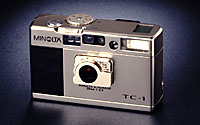
|
|
TC-1 Stats
|
|
Type: 35mm compact auto/manual focus, aperture priority, built-in flash camera
|
|
Size: 3¼x2¼x1¼ in.
|
|
Weight: (without battery): 6.5 oz.
|
|
Lens 28mm f/3.5mm; 5 all-glass elements in 5 groups; 3 aspherical surfaces
|
|
Viewfinder: Real-image type with 0.4x mag. 85% field of view at 9.8ft.; diopter adjustment from -2.5 to +1
|
|
Focus: External, passive-type AF with focus lock; built-in LED-type AF illuminator
activated automatically in low light or low contrast situations; AF illum. range: 8.2 ft.
|
|
Maximum magnification: 1/13.5x
|
|
Focusing Steps: 455 for autofocus; manual focus with 22 selectable zones
|
|
Focus Range: 1.47 ft. to infinity
|
|
Exposure: Aperture-priority program; manual aperture settings f/3.5, 5.6, 8, 16
|
|
Shutter: Programmed automatic electronic type; speeds: 4 - 1/750 sec.
|
|
Film Speed Setting: Automatic setting for DX-coded print or slide films; manual setting available. Non-DX-coded film set to 100
|
|
SISO Range: (auto): ISO 25 - 3200 in 1/3 EV increments; (manual): ISO 6-6400 in 1/3 increments
|
|
Flash: Built-in fixed type with auto, cancel, fill, and night portrait (slow shutter sync) modes. Range at ISO 100: 1.47 - 6.5 ft.; recycling time 5 seconds; guide number 23
feet
|
|
Power: One 3V CR123A/DL123A lithium cell
|
|
Battery Performance: Approx. 13 rolls (24-exposure film with flash on 50%)
|
|
Price: $1000+
|
Gem of a Point and Shoot
The Minolta TC-1
I never liked point-and-shoot cameras. Most lack edge-to-edge sharpness.
It's
difficult or impossible to adjust exposure when shooting in the snow.
Fit
and
finish often seem below par. And I prefer wide lenses if confined to one
focal
length. Even the highest quality models fell short one way or another.
Until
now.
Finally, Minolta created a little jewel that counters all my objections,
the
TC-1. The camera is about the size of a pack of cigarettes (3 1/4 x 2
1/4 x 1 1/4 inches), small enough to fit into a shirt pocket. A metal case houses
the
innards. When you turn off the camera, a sheet of metal covers and
protects
the lens.
"I
can't
detect a difference between the little Minolta and my equivalent EOS
lens...."
|
 |
 |  |  |  |
Apertures range from a fast f3.5 for capturing action to f16, sufficient
for
full depth of filed landscapes. A small flash adds fill. You can use the
default center-weighted meter or switch to a built-in spot. A timer
allows
you
to dash into your shot or to avoid camera shake on longer exposures when
using
a tripod. The timer replaces a cable release. While I miss manual
operation,
the ability to perform exposure compensation with the aperture priority
system
allows me to get the exposure right when conditions would otherwise fool
the
meter.
Best of all, the glass is great. The 28mm lens is wider than most, and I
see
no light fall off or fuzziness at the edges of my slides. This is where
the
rubber meets the road. Without good glass it's impossible to take
professional
quality shots regardless of the bells and whistles. The TC-1 passes. I
can't
detect a difference between the little Minolta and my equivalent EOS
lens.
But jewels are pricey. The TC-1 runs $1500 in stores and almost $1,000
by
mail
order. Sadly, the iron law of econimics states, " you get what you pay
for."
I used to miss photographs because I didn't want to lug my gear over
hill
and
dale. I would make excuses to myself- the light is bad, I'll just scout
a
location for later, looks like rain- and then miss out on a surprise
marvel.
The TC-1 is always welcome, never a burden. Now I never lose shots to
sloth
or
pessimism.
— James Martin, Mountain Photographer
|

